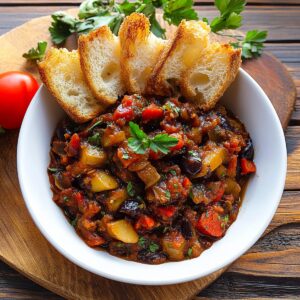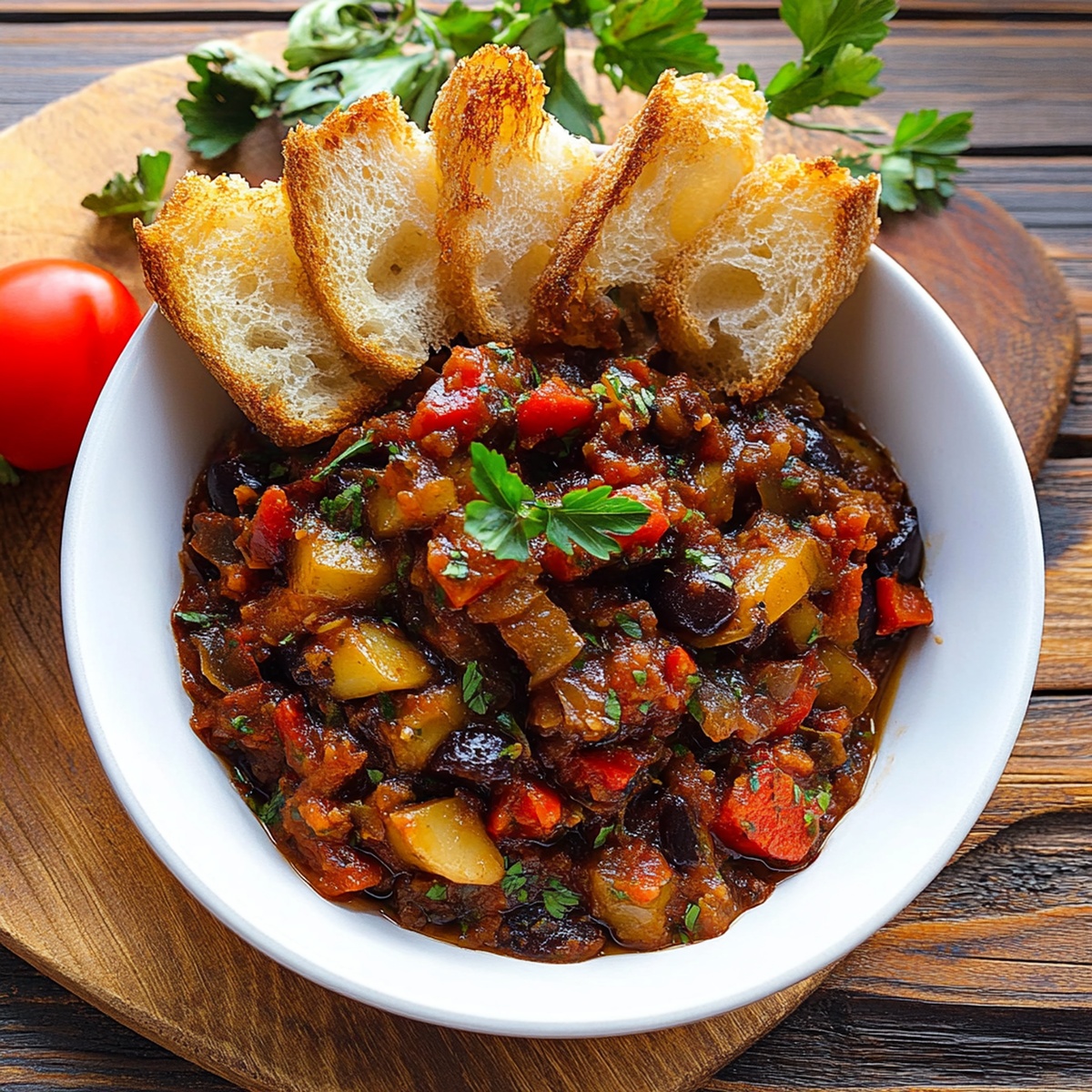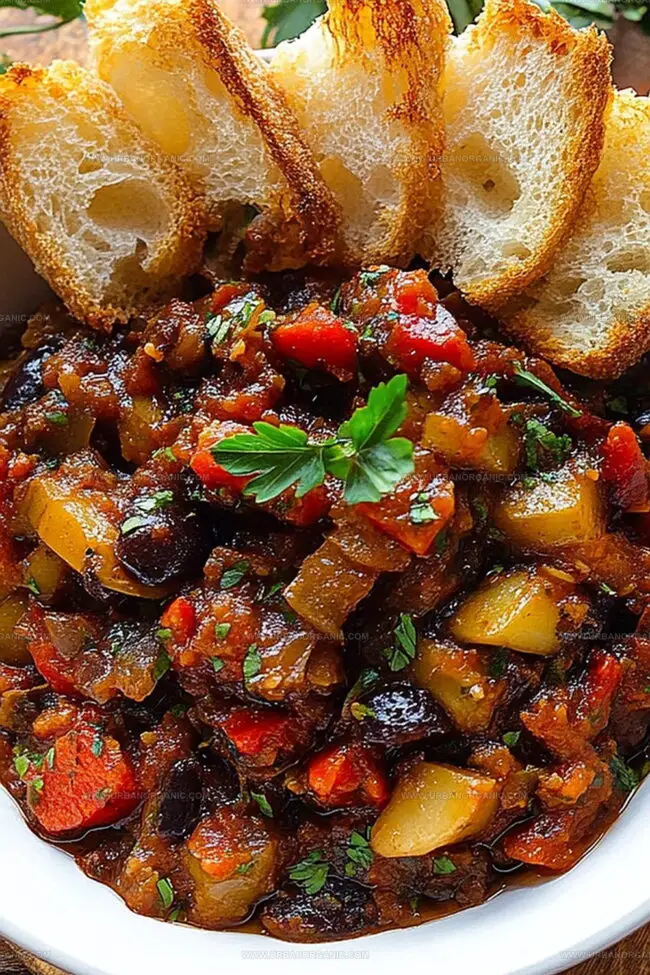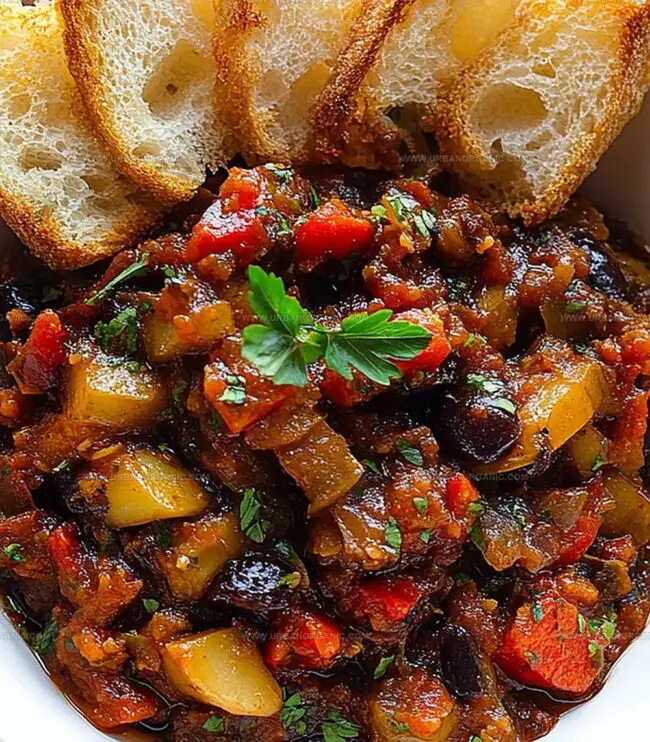Irresistibly Tangy Sicilian Caponata Recipe for Summer Meals
Sicily’s beloved caponata recipe weaves a tapestry of rustic flavors that dance across your palate with Mediterranean charm.
Eggplant, the star ingredient, mingles with vibrant tomatoes and briny olives in a delightful culinary symphony.
Sweet and tangy notes emerge from carefully caramelized vegetables, creating a complex taste profile that whispers of sun-drenched landscapes.
Regional cooks have perfected this dish through generations, each adding their personal touch to the classic preparation.
Crisp textures contrast with soft, mellow undertones, inviting you to savor every delectable bite.
Olive oil and vinegar provide a subtle backdrop that enhances the vegetable medley’s rich character.
You’ll want to serve this traditional appetizer alongside crusty bread, letting the flavors transport you directly to an Italian kitchen.
What Makes Caponata a Flavor-Packed Dish
Must-Have Ingredients for Classic Caponata
Main Ingredients:
Vegetable Base:Flavor Enhancers:Seasoning and Liquid Components:Garnish and Finishing:Cooking Caponata Without Overcomplicating Things
Step 1: Prepare Eggplant Moisture Removal
Dice the eggplant and sprinkle generously with salt in a colander. Allow it to rest for half an hour, letting excess water drain away. Rinse thoroughly and pat completely dry with paper towels.
Step 2: Golden Sauteing Adventure
Heat olive oil in a spacious skillet over medium warmth. Cook eggplant in separate batches, transforming each piece into a golden-brown delight. Rotate pieces to ensure even caramelization. Remove and set aside on a clean plate.
Step 3: Vegetable Symphony
In the same skillet, add additional oil if needed. Toss in:Saute until vegetables become tender and slightly translucent. Introduce minced garlic and cook for an additional minute, releasing its aromatic essence.
Step 4: Flavor Explosion
Incorporate into the skillet:Stir enthusiastically and allow mixture to simmer for five minutes. Gently return the golden eggplant pieces to the pan.
Step 5: Gentle Simmering Magic
Reduce heat to low. Let the mixture bubble softly for 10-15 minutes, allowing flavors to meld and intensify. Taste and adjust seasoning with salt, pepper, additional vinegar, or sugar as your palate desires.
Step 6: Cooling and Presenting
Allow the caponata to cool to room temperature. Serve alongside crusty bread or as a vibrant side dish. Optional elegant touches include scattering fresh herbs and toasted pine nuts on top.
Smart Tips for Balanced Sweet and Savory Caponata
How to Keep Caponata Tasting Fresh
Dishes That Pair Well with Caponata
Caponata Variations from Italy and Beyond
Everything You Want to Know About Caponata
Salting helps draw out excess moisture and bitterness from the eggplant, which improves its texture and prevents it from becoming soggy during cooking.
Cooking eggplant in batches ensures each piece gets golden and crispy without overcrowding the pan, which would cause steaming instead of proper browning.
Yes, caponata actually tastes better when made in advance, as the flavors have time to meld together. You can prepare it a day or two before serving and store it in the refrigerator.
Caponata is naturally vegetarian and can even be vegan if you skip any optional dairy garnishes, making it a versatile and healthy side dish or appetizer.
Print
Caponata Recipe
- Total Time: 45 minutes
- Yield: 4 1x
Description
Sicilian caponata brings together eggplant, tomatoes, and olives in a symphony of sweet-and-sour flavors. Rich with Mediterranean herbs and balanced tanginess, this classic Italian dish offers a delightful culinary journey you’ll savor to the last bite.
Ingredients
Main Vegetables:
- 2 medium eggplants, diced (about 1.5 pounds / 680 grams)
- 1 small yellow onion, diced
- 2 celery stalks, diced
- 1 red bell pepper, diced
Tomato Base:
- 1 (14 ounces / 400 grams) can diced tomatoes (or 1.5 cups fresh chopped tomatoes)
- 2 tablespoons tomato paste
Additional Ingredients:
- ¼ cup olive oil (plus more as needed)
- 3 cloves garlic, minced
- ¼ cup green or black olives, chopped
- 2 tablespoons capers, drained
- 2–3 tablespoons red wine vinegar
- 1 tablespoon sugar
- 2 tablespoons golden raisins (optional)
Salt and Seasonings:
- Salt, for sweating eggplant
- Black pepper, to taste
Garnish:
- Fresh parsley or basil, for garnish
- Optional: toasted pine nuts, for topping
Instructions
- Purge excess moisture from eggplant cubes by salting them thoroughly in a colander for half an hour, then rinse and thoroughly dry with clean kitchen towels.
- Heat generous olive oil in a spacious skillet over medium temperature, carefully frying eggplant pieces in multiple batches until they transform into golden, tender morsels, approximately 8-10 minutes per batch.
- Remove eggplant and utilize the same skillet, adding additional oil if necessary, to gently sauté chopped onions, celery, and bell peppers until they soften and become translucent.
- Introduce minced garlic and cook briefly, allowing its aromatic essence to permeate the vegetable mixture.
- Incorporate diced tomatoes, concentrated tomato paste, briny olives, tangy capers, sweet raisins, robust vinegar, and a touch of sugar into the vegetable medley.
- Simmer the mixture for approximately 5 minutes, creating a rich, complex flavor profile.
- Reintroduce the previously cooked eggplant to the skillet, allowing all ingredients to meld together harmoniously.
- Reduce heat and let the caponata gently simmer, stirring occasionally, for 10-12 minutes until the sauce thickens and flavors intensify.
- Adjust seasoning with salt, pepper, additional vinegar, or sugar to achieve a balanced taste.
- Allow the caponata to cool to room temperature, developing deeper flavors as it rests.
- Serve alongside crusty bread or as a versatile side dish, optionally garnishing with fresh herbs and toasted pine nuts for added texture and visual appeal.
Notes
- Sweat eggplant before cooking to remove excess moisture and prevent soggy texture by salting and letting it sit for 30 minutes.
- Use high-quality extra virgin olive oil for richer flavor and better caramelization when sautéing vegetables.
- Adjust sweetness and acidity by carefully balancing vinegar and sugar to create a harmonious taste profile that complements the vegetables.
- Make this dish vegan-friendly by ensuring all ingredients are plant-based and serve as a versatile appetizer or side dish that works well with multiple cuisines.
- Prep Time: 15 minutes
- Cook Time: 30 minutes
- Category: Appetizer, Lunch, Dinner
- Method: Sautéing
- Cuisine: Italian
Nutrition
- Serving Size: 4
- Calories: 200
- Sugar: 3 g
- Sodium: 350 mg
- Fat: 18 g
- Saturated Fat: 4 g
- Unsaturated Fat: 12 g
- Trans Fat: 0 g
- Carbohydrates: 10 g
- Fiber: 3 g
- Protein: 5 g
- Cholesterol: 15 mg




Jessica Martinez
Pastry Chef & Recipe Developer
Expertise
Organic Baking Techniques, Gluten-Free Recipe Development, Southwestern Dessert Specialties, Food Styling and Photography
Education
Santa Fe Community College (SFCC)
Jessica brings the sweet side to Urban Organic with her passion for baking and love for the Southwest. She trained at Santa Fe Community College and has built a career creating beautiful, gluten-free, and organic desserts that feel both nostalgic and new.
She believes baking should be fun, creative, and open to everyone, no matter your diet or skill level. Jessica’s recipes are simple enough to follow, but special enough to remember.